Tikal Guatemala - a great place to travel
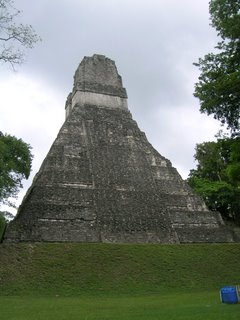
Some History:
From 250 to 550 a.d., Tikal was a wealthy metropolis of 150,000 people and covered over 20 square miles. It was a seat of power for the great Jaguar clan lords. The ruins of Tikal include more than 3,000 structures extending over six square miles and including palaces, temples, ceremonial platforms, ball courts, terraces, plazas, avenues and steam baths. The ancient Maya began building Tikal around 600 B.C. The city was at its height in the Maya Classic Period, approximately 200 AD to 850 AD, after which no new major monuments were built. Sometime in the ninth century, for what is now believed to be a combination of cultural and environmental reasons, the city was abandoned to the jungle - the last date carved into the monuments was 869 a.d. The most prominent surviving buildings include six very large step pyramids supporting temples on their tops.
A unique blend of burnt limestone and water was used as mortar to cement the blocks together the Maya used no beasts-of-burden, no iron tools to cut stone, and no wheels for transport. The massive stones were used to record the events of the time. Many are covered with glyphic writing, and pictures.
Mayans calculated that one Earth year was a little more than 365 days, an estimate that differs by only .002 of a day from today's modern estimation of a year. Another fantastic example of their obsession with time and accuracy concerned the planet Venus. The Mayans calculated a Venetian year to be 489 days, accurate to within two days of the modern estimate.


If you are willing to chance it, tourists today can climb all but Temple I. The stairs are just as they look, small, rickety and unkept. The reward from the top is a view that is priceless. One can see both the massive jungle and the Tikal structures.From the top one can hear howler monkeys but cannot tell how close they are.
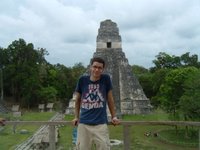

Temple II is over 125 feet tall and faces another almost identical temple (Temple I) across the plaza.. Temple II was constructed sometime after Temple I, in the middle of the 8th century AD. Both of these temples have very little space inside. The only rooms were those located at the top. The relative shortage of interior space supports the belief that these buildings were reserved for religious and ceremonial use, and only for the highest nobility in the society. Another amazing feature of these temples is the unbelievable acoustics. Anyone can speak between the tops of the two temples without raising their voice. Again if you climb, be prepared for little support.
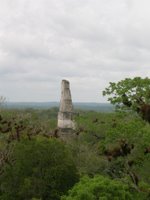
Temple IV, is stone structure built by Ah Cacau's son around 741 AD. It towers 212 feet above the jungle floor, making it the tallest structure in North America before the construction of the skyscrapers in the late 1800's. Looking out from the top of the Temple IV, over the jungle canopy, it is possible to see the Great Plaza and Mundo Perdido in the distance.
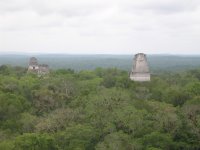
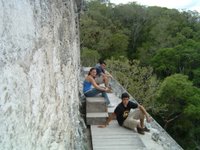

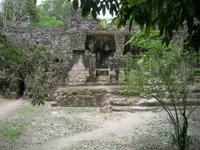
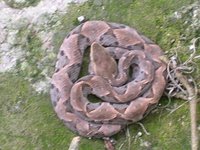 Mundo Perdido is thought to be the oldest of all the structural complexes found in Tikal, and has many unique characteristics. Mundo Perdido has experienced periods of building and rebuilding. Its earliest structures were dated prior to 500 BC, making it perhaps the original center of Tikal. Today, researchers theorize that this part of Tikal was more of a calendric ceremonial complex, differentiating it from the other temple structures that were built to memorialize the dead. It is believed that this area was accessible not only to the royalty, but also to the common people. Watch where you step!!! you may be in for a surprise.
Mundo Perdido is thought to be the oldest of all the structural complexes found in Tikal, and has many unique characteristics. Mundo Perdido has experienced periods of building and rebuilding. Its earliest structures were dated prior to 500 BC, making it perhaps the original center of Tikal. Today, researchers theorize that this part of Tikal was more of a calendric ceremonial complex, differentiating it from the other temple structures that were built to memorialize the dead. It is believed that this area was accessible not only to the royalty, but also to the common people. Watch where you step!!! you may be in for a surprise.
Fun Facts:
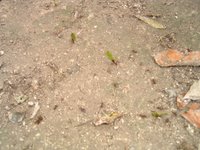 Leaf Cutter Ants march in large numbers to a tree, wearing a path
Leaf Cutter Ants march in large numbers to a tree, wearing a path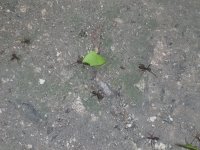 into the jungle floor sometimes inches deep. Each ant bites off a leaf section several times its own body weight and carries it back to the nest, sometimes as far as a mile away. At the nest the ants chew the leaves and spit them out creating a compost where mushrooms grow. The ants harvest the mushrooms and feed the colony. If the leaves are too dry the ants put them outside the nest overnight to gather moisture, if they are too moist they leave them out during the day. If the leaves get soaked, they throw them out and start over. These insects are farmers.
into the jungle floor sometimes inches deep. Each ant bites off a leaf section several times its own body weight and carries it back to the nest, sometimes as far as a mile away. At the nest the ants chew the leaves and spit them out creating a compost where mushrooms grow. The ants harvest the mushrooms and feed the colony. If the leaves are too dry the ants put them outside the nest overnight to gather moisture, if they are too moist they leave them out during the day. If the leaves get soaked, they throw them out and start over. These insects are farmers.
Advice:
Stay on the path
Be in shape and don't be afaid to climb.
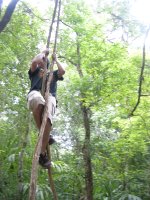



0 Comments:
Post a Comment
<< Home